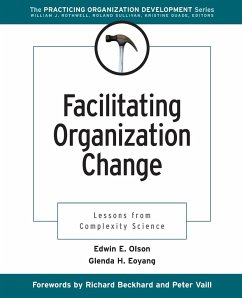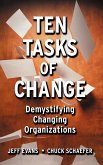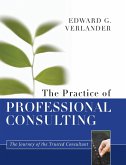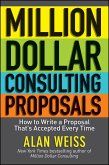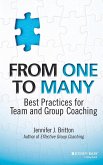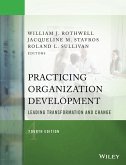- Broschiertes Buch
- Merkliste
- Auf die Merkliste
- Bewerten Bewerten
- Teilen
- Produkt teilen
- Produkterinnerung
- Produkterinnerung
"Facilitating Organization Change" hilft Ihnen, die Dynamik des Wandels in einem komplexen System zu verstehen und diese Kräfte gezielt zu nutzen. Dieses Buch nennt neue Perspektiven, Methoden und Techniken zur Wiederbelebung von Unternehmen. Es erläutert auch die Muster die das Unternehmensverhalten steuern und zeigt, wie man sich diese Einsichten zunutze macht, um den Unternehmenswandel effektiver voranzutreiben. Leaders and facilitators of organization and system change know intuitively that the context of the work is complex and adaptive, but most have not been exposed to the concepts of…mehr
Andere Kunden interessierten sich auch für
![Ten Tasks of Change Ten Tasks of Change]() Jeff EvansTen Tasks of Change55,99 €
Jeff EvansTen Tasks of Change55,99 €![The Practice of Professional C The Practice of Professional C]() Edward G. VerlanderThe Practice of Professional C64,99 €
Edward G. VerlanderThe Practice of Professional C64,99 €![Organisationen selber verändern Organisationen selber verändern]() Frank HeideloffOrganisationen selber verändern31,95 €
Frank HeideloffOrganisationen selber verändern31,95 €![Million Dollar Consulting Proposals Million Dollar Consulting Proposals]() Alan WeissMillion Dollar Consulting Proposals24,99 €
Alan WeissMillion Dollar Consulting Proposals24,99 €![Professional Services Marketing Professional Services Marketing]() Mike SchultzProfessional Services Marketing27,99 €
Mike SchultzProfessional Services Marketing27,99 €![From One to Many From One to Many]() Jennifer J. BrittonFrom One to Many44,99 €
Jennifer J. BrittonFrom One to Many44,99 €![Practicing Organization Development Practicing Organization Development]() Practicing Organization Development110,99 €
Practicing Organization Development110,99 €-
-
-
"Facilitating Organization Change" hilft Ihnen, die Dynamik des Wandels in einem komplexen System zu verstehen und diese Kräfte gezielt zu nutzen. Dieses Buch nennt neue Perspektiven, Methoden und Techniken zur Wiederbelebung von Unternehmen. Es erläutert auch die Muster die das Unternehmensverhalten steuern und zeigt, wie man sich diese Einsichten zunutze macht, um den Unternehmenswandel effektiver voranzutreiben.
Leaders and facilitators of organization and system change know intuitively that the context of the work is complex and adaptive, but most have not been exposed to the concepts of complexity science. Without a language and a set of models, they find it difficult to understand or make use of the complexity that inevitably surrounds them.
Hinweis: Dieser Artikel kann nur an eine deutsche Lieferadresse ausgeliefert werden.
Leaders and facilitators of organization and system change know intuitively that the context of the work is complex and adaptive, but most have not been exposed to the concepts of complexity science. Without a language and a set of models, they find it difficult to understand or make use of the complexity that inevitably surrounds them.
Hinweis: Dieser Artikel kann nur an eine deutsche Lieferadresse ausgeliefert werden.
Produktdetails
- Produktdetails
- J-B The Practicing Organization Development Series
- Verlag: Jossey-Bass Publishers / Wiley & Sons
- 1. Auflage
- Seitenzahl: 240
- Erscheinungstermin: 21. Februar 2001
- Englisch
- Abmessung: 235mm x 191mm x 14mm
- Gewicht: 462g
- ISBN-13: 9780787953300
- ISBN-10: 078795330X
- Artikelnr.: 09697070
- Herstellerkennzeichnung
- Libri GmbH
- Europaallee 1
- 36244 Bad Hersfeld
- 06621 890
- J-B The Practicing Organization Development Series
- Verlag: Jossey-Bass Publishers / Wiley & Sons
- 1. Auflage
- Seitenzahl: 240
- Erscheinungstermin: 21. Februar 2001
- Englisch
- Abmessung: 235mm x 191mm x 14mm
- Gewicht: 462g
- ISBN-13: 9780787953300
- ISBN-10: 078795330X
- Artikelnr.: 09697070
- Herstellerkennzeichnung
- Libri GmbH
- Europaallee 1
- 36244 Bad Hersfeld
- 06621 890
Edwin E. Olson, PhD, earned a master's degree in pastoral counseling and a PhD in government. He teaches organization behavior at the University of Maryland, University College. Glenda H. Eoyang is the author of Facilitating Organization Change: Lessons from Complexity Science, published by Wiley.
List of Tables, Figures, and Exhibits ix
Foreword to the Series xi
Introduction to the Series xiii
Statement of the Board xvii
Foreword xxiii
Dedication xxx
Preface xxxi
Acknowledgments xxxix
Self-Diagnosis xli
1. An Emerging Paradigm of Organization Change 1
Organization As Machine 2
Problem with Traditional Approaches 4
Alternatives to the Machine Model 6
Toward an Integrated Framework 7
From the Part to the Whole 10
From the Whole to the Part 10
Emergent Patterns Through Self-Organization 11
Conditions for Self-Organization 11
The Self-Organizing Process 15
No Condition Stands Alone 16
CAS and the Change Agent 18
Summary 19
Method: Self-Organizing Dynamics 20
2. Change Through Connections (Not Top-Down Control) 25
Story: Hospital Merger 26
Entangled Connections 27
No Single Source of Change 29
Leadership and Influence in a CAS 31
Role of Formal Leader 33
Change Agent Role 37
Summary 39
Method: Feedback Analysis 40
Method: Leader As Change Agent 45
3. Adapt to Uncertainty (Not Predictable Stages of Development) 49
Nonlinear Organization Change 51
Story: Unpredictability vs. Need for Control 52
Consulting to Uncertainty 54
No Sequence of Events 55
Speed of Adaptation 56
Change Agent Role 60
Summary 62
Method: Decision Making Under Conditions of Uncertainty 63
4. Emerging Goals, Plans, and Structures (Not Clear, Detailed Plans or
Goals) 69
Case: Knowledge Management Firms 71
Planning in a CAS 72
Vision in a CAS 73
Goal Setting in a CAS 75
Structures in a CAS 75
Change Agent Role 80
Summary 81
Method: Self-Organizing Exercise 81
5. Amplify Difference (Not Build Consensus) 85
Story: The Hidden Difference 86
Unbraiding Differences 88
Differences in a CAS 89
Differences and Organization Resilience 90
Differences and Organization Change 91
Change Agent Role 93
Summary 94
Method: Difference Matrix 95
6. Self-Similarity (Not Differences Between Levels) 101
Story: The Hidden Difference (Continued) 102
Self-Similarity in Organizations 103
Scaling 104
Scaling in Organizations 104
Simple Rules 106
Change Agent Role 107
Summary 108
Method: Fractal As Metaphor 108
7. Success As Fit with the Environment (Not Closing the Gap with an Ideal)
115
Story: Focusing on Fit 116
Success As Fitness 118
Performance Feedback 121
Competition and Cooperation 122
Change Agent Role 124
Summary 125
Method: Same and Different 126
8. Self-Organization and the Change Agent: Tips for Thriving in the New
Paradigm 131
Story: Just Do It! 132
Self-Organization and Traditional Change Methods 134
Change Agent Responsibilities 135
Entering the System 138
Assessment 139
Intervention 141
Evaluation 144
Skills for a Complexity Approach 146
Summary 148
Method: Reflection Evaluation 149
9. Making Self-Organization a Reality: Evolution in Organizations 155
Work with the Conditions for Self-Organization 157
Conclusion 164
Continuing the Co-Evolution 165
References 167
About the Authors 173
About the Editors 175
Index 179
Foreword to the Series xi
Introduction to the Series xiii
Statement of the Board xvii
Foreword xxiii
Dedication xxx
Preface xxxi
Acknowledgments xxxix
Self-Diagnosis xli
1. An Emerging Paradigm of Organization Change 1
Organization As Machine 2
Problem with Traditional Approaches 4
Alternatives to the Machine Model 6
Toward an Integrated Framework 7
From the Part to the Whole 10
From the Whole to the Part 10
Emergent Patterns Through Self-Organization 11
Conditions for Self-Organization 11
The Self-Organizing Process 15
No Condition Stands Alone 16
CAS and the Change Agent 18
Summary 19
Method: Self-Organizing Dynamics 20
2. Change Through Connections (Not Top-Down Control) 25
Story: Hospital Merger 26
Entangled Connections 27
No Single Source of Change 29
Leadership and Influence in a CAS 31
Role of Formal Leader 33
Change Agent Role 37
Summary 39
Method: Feedback Analysis 40
Method: Leader As Change Agent 45
3. Adapt to Uncertainty (Not Predictable Stages of Development) 49
Nonlinear Organization Change 51
Story: Unpredictability vs. Need for Control 52
Consulting to Uncertainty 54
No Sequence of Events 55
Speed of Adaptation 56
Change Agent Role 60
Summary 62
Method: Decision Making Under Conditions of Uncertainty 63
4. Emerging Goals, Plans, and Structures (Not Clear, Detailed Plans or
Goals) 69
Case: Knowledge Management Firms 71
Planning in a CAS 72
Vision in a CAS 73
Goal Setting in a CAS 75
Structures in a CAS 75
Change Agent Role 80
Summary 81
Method: Self-Organizing Exercise 81
5. Amplify Difference (Not Build Consensus) 85
Story: The Hidden Difference 86
Unbraiding Differences 88
Differences in a CAS 89
Differences and Organization Resilience 90
Differences and Organization Change 91
Change Agent Role 93
Summary 94
Method: Difference Matrix 95
6. Self-Similarity (Not Differences Between Levels) 101
Story: The Hidden Difference (Continued) 102
Self-Similarity in Organizations 103
Scaling 104
Scaling in Organizations 104
Simple Rules 106
Change Agent Role 107
Summary 108
Method: Fractal As Metaphor 108
7. Success As Fit with the Environment (Not Closing the Gap with an Ideal)
115
Story: Focusing on Fit 116
Success As Fitness 118
Performance Feedback 121
Competition and Cooperation 122
Change Agent Role 124
Summary 125
Method: Same and Different 126
8. Self-Organization and the Change Agent: Tips for Thriving in the New
Paradigm 131
Story: Just Do It! 132
Self-Organization and Traditional Change Methods 134
Change Agent Responsibilities 135
Entering the System 138
Assessment 139
Intervention 141
Evaluation 144
Skills for a Complexity Approach 146
Summary 148
Method: Reflection Evaluation 149
9. Making Self-Organization a Reality: Evolution in Organizations 155
Work with the Conditions for Self-Organization 157
Conclusion 164
Continuing the Co-Evolution 165
References 167
About the Authors 173
About the Editors 175
Index 179
List of Tables, Figures, and Exhibits ix
Foreword to the Series xi
Introduction to the Series xiii
Statement of the Board xvii
Foreword xxiii
Dedication xxx
Preface xxxi
Acknowledgments xxxix
Self-Diagnosis xli
1. An Emerging Paradigm of Organization Change 1
Organization As Machine 2
Problem with Traditional Approaches 4
Alternatives to the Machine Model 6
Toward an Integrated Framework 7
From the Part to the Whole 10
From the Whole to the Part 10
Emergent Patterns Through Self-Organization 11
Conditions for Self-Organization 11
The Self-Organizing Process 15
No Condition Stands Alone 16
CAS and the Change Agent 18
Summary 19
Method: Self-Organizing Dynamics 20
2. Change Through Connections (Not Top-Down Control) 25
Story: Hospital Merger 26
Entangled Connections 27
No Single Source of Change 29
Leadership and Influence in a CAS 31
Role of Formal Leader 33
Change Agent Role 37
Summary 39
Method: Feedback Analysis 40
Method: Leader As Change Agent 45
3. Adapt to Uncertainty (Not Predictable Stages of Development) 49
Nonlinear Organization Change 51
Story: Unpredictability vs. Need for Control 52
Consulting to Uncertainty 54
No Sequence of Events 55
Speed of Adaptation 56
Change Agent Role 60
Summary 62
Method: Decision Making Under Conditions of Uncertainty 63
4. Emerging Goals, Plans, and Structures (Not Clear, Detailed Plans or
Goals) 69
Case: Knowledge Management Firms 71
Planning in a CAS 72
Vision in a CAS 73
Goal Setting in a CAS 75
Structures in a CAS 75
Change Agent Role 80
Summary 81
Method: Self-Organizing Exercise 81
5. Amplify Difference (Not Build Consensus) 85
Story: The Hidden Difference 86
Unbraiding Differences 88
Differences in a CAS 89
Differences and Organization Resilience 90
Differences and Organization Change 91
Change Agent Role 93
Summary 94
Method: Difference Matrix 95
6. Self-Similarity (Not Differences Between Levels) 101
Story: The Hidden Difference (Continued) 102
Self-Similarity in Organizations 103
Scaling 104
Scaling in Organizations 104
Simple Rules 106
Change Agent Role 107
Summary 108
Method: Fractal As Metaphor 108
7. Success As Fit with the Environment (Not Closing the Gap with an Ideal)
115
Story: Focusing on Fit 116
Success As Fitness 118
Performance Feedback 121
Competition and Cooperation 122
Change Agent Role 124
Summary 125
Method: Same and Different 126
8. Self-Organization and the Change Agent: Tips for Thriving in the New
Paradigm 131
Story: Just Do It! 132
Self-Organization and Traditional Change Methods 134
Change Agent Responsibilities 135
Entering the System 138
Assessment 139
Intervention 141
Evaluation 144
Skills for a Complexity Approach 146
Summary 148
Method: Reflection Evaluation 149
9. Making Self-Organization a Reality: Evolution in Organizations 155
Work with the Conditions for Self-Organization 157
Conclusion 164
Continuing the Co-Evolution 165
References 167
About the Authors 173
About the Editors 175
Index 179
Foreword to the Series xi
Introduction to the Series xiii
Statement of the Board xvii
Foreword xxiii
Dedication xxx
Preface xxxi
Acknowledgments xxxix
Self-Diagnosis xli
1. An Emerging Paradigm of Organization Change 1
Organization As Machine 2
Problem with Traditional Approaches 4
Alternatives to the Machine Model 6
Toward an Integrated Framework 7
From the Part to the Whole 10
From the Whole to the Part 10
Emergent Patterns Through Self-Organization 11
Conditions for Self-Organization 11
The Self-Organizing Process 15
No Condition Stands Alone 16
CAS and the Change Agent 18
Summary 19
Method: Self-Organizing Dynamics 20
2. Change Through Connections (Not Top-Down Control) 25
Story: Hospital Merger 26
Entangled Connections 27
No Single Source of Change 29
Leadership and Influence in a CAS 31
Role of Formal Leader 33
Change Agent Role 37
Summary 39
Method: Feedback Analysis 40
Method: Leader As Change Agent 45
3. Adapt to Uncertainty (Not Predictable Stages of Development) 49
Nonlinear Organization Change 51
Story: Unpredictability vs. Need for Control 52
Consulting to Uncertainty 54
No Sequence of Events 55
Speed of Adaptation 56
Change Agent Role 60
Summary 62
Method: Decision Making Under Conditions of Uncertainty 63
4. Emerging Goals, Plans, and Structures (Not Clear, Detailed Plans or
Goals) 69
Case: Knowledge Management Firms 71
Planning in a CAS 72
Vision in a CAS 73
Goal Setting in a CAS 75
Structures in a CAS 75
Change Agent Role 80
Summary 81
Method: Self-Organizing Exercise 81
5. Amplify Difference (Not Build Consensus) 85
Story: The Hidden Difference 86
Unbraiding Differences 88
Differences in a CAS 89
Differences and Organization Resilience 90
Differences and Organization Change 91
Change Agent Role 93
Summary 94
Method: Difference Matrix 95
6. Self-Similarity (Not Differences Between Levels) 101
Story: The Hidden Difference (Continued) 102
Self-Similarity in Organizations 103
Scaling 104
Scaling in Organizations 104
Simple Rules 106
Change Agent Role 107
Summary 108
Method: Fractal As Metaphor 108
7. Success As Fit with the Environment (Not Closing the Gap with an Ideal)
115
Story: Focusing on Fit 116
Success As Fitness 118
Performance Feedback 121
Competition and Cooperation 122
Change Agent Role 124
Summary 125
Method: Same and Different 126
8. Self-Organization and the Change Agent: Tips for Thriving in the New
Paradigm 131
Story: Just Do It! 132
Self-Organization and Traditional Change Methods 134
Change Agent Responsibilities 135
Entering the System 138
Assessment 139
Intervention 141
Evaluation 144
Skills for a Complexity Approach 146
Summary 148
Method: Reflection Evaluation 149
9. Making Self-Organization a Reality: Evolution in Organizations 155
Work with the Conditions for Self-Organization 157
Conclusion 164
Continuing the Co-Evolution 165
References 167
About the Authors 173
About the Editors 175
Index 179

